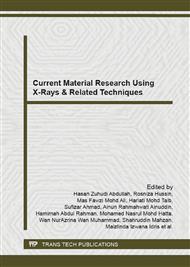p.1
p.6
p.11
p.16
p.20
p.25
p.30
p.35
Tensile Behaviour and Fracture Characteristics of Polydimethylsiloxane (PDMS) Filled Silica Composites
Abstract:
The focus of this study is to investigate the mechanical properties and fracture behaviour of polydimethylsiloxane filled crystalline silica composites (PDMS/CS) upon tensile loading. The PDMS/CS composites were fabricated by using casting method and cured at room temperature for 24 hours. Crystalline silica (CS) were added to PDMS at compositions of 2, 6, 10 wt%. The tensile properties of PDMS/2wt%CS showed that the tensile stress were improved by 4.3%. Fracture behaviour as determined by the characteristic of fracture surface of pure PDMS and PDMS/CS composites were analysed using Field Emission Scanning Electron Microscopy (FESEM) and Atomic Force Microscopy (AFM). Observation via FESEM and AFM indicated different fracture characteristic of filled PDMS and unfilled PDMS. The addition of CS as fillers were indeed proven to improve the strength of the composites.
Info:
Periodical:
Pages:
6-10
Citation:
Online since:
February 2015
Authors:
Keywords:
Price:
Сopyright:
© 2015 Trans Tech Publications Ltd. All Rights Reserved
Share:
Citation:


